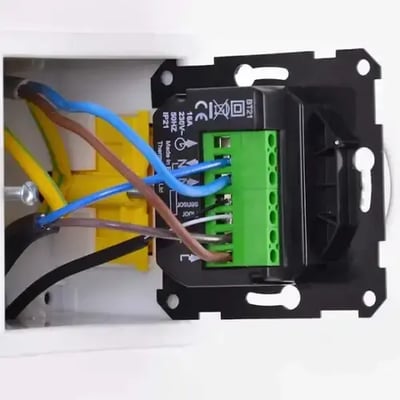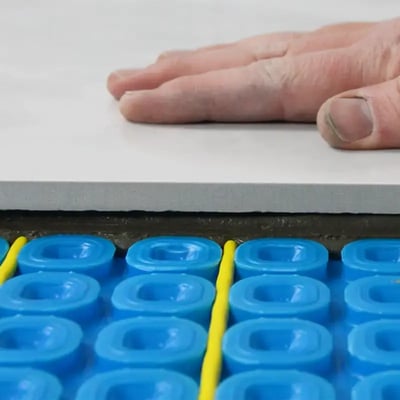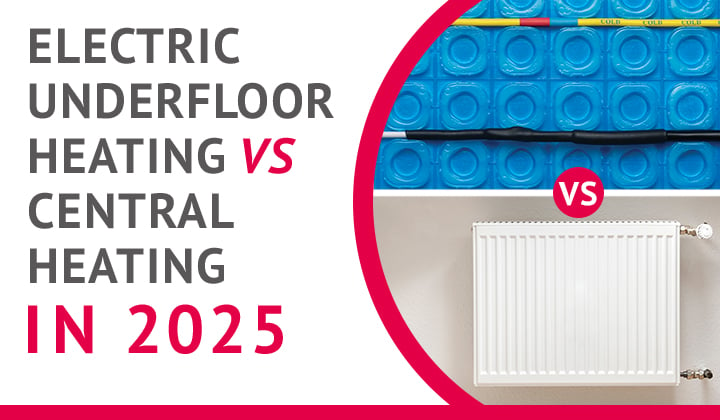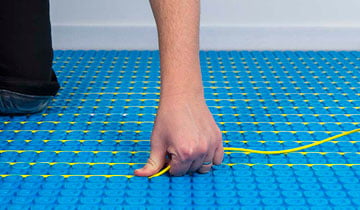12 min read
Electric underfloor heating vs central heating in 2025 – which makes more sense?
For decades, gas central heating has been the go-to choice for UK homes — reliable, familiar and deeply ingrained in how we think about warmth. But...

There’s nothing quite like stepping onto a warm floor on a chilly morning — which is why it’s so frustrating when your underfloor heating doesn’t do what it’s supposed to. Cold tiles, unresponsive thermostats or heating that just doesn’t seem to kick in can leave you wondering whether something’s seriously wrong.
The good news is that, in most cases, the problem isn’t nearly as big as it feels. Electric underfloor heating systems are simple, reliable and built to last. When they stop working unexpectedly, the culprit is often something small and fixable. In this guide, we’ll walk you through the most common causes, the first checks you can do yourself and when it’s time to call ThermoSphere for support. At the end of the day, “electric heating made easy” isn’t just our tagline, it’s our promise.
 Before you assume the worst, it’s always worth ruling out the basics. You’d be surprised how often a cold floor comes down to something minor.
Before you assume the worst, it’s always worth ruling out the basics. You’d be surprised how often a cold floor comes down to something minor.
1. Check for power. The first thing to do is make sure the system is actually receiving power. A switch on the fused spur might have been turned off without you realising, or a circuit breaker could have tripped. If your consumer unit has an RCD (residual current device), check that it hasn’t cut out either. Without power, the heating can’t do anything at all. You can usually tell if the circuit has power by looking at the thermostat. Usually, the display will show signs of life or there will be a power indicator light.
2. Once you know the system is live, turn your attention to the thermostat. Ask yourself: is it switched on, in the correct mode and actually calling for heat? If the thermostat is set to a schedule, it could be simply waiting until the next programmed heating period. Switching it to manual mode and raising the temperature a few degrees is an easy way to test whether the floor responds.
3. It’s also important to remember that underfloor heating is not an instant system. It doesn’t blast hot air like a fan heater. Depending on the floor finish and how well insulated your subfloor is, it can take a couple of hours for the surface temperature to rise to something you feel underfoot. If the system has been off for a long stretch (all summer for example) that first warm-up will feel slower than usual. Sometimes patience is all that’s required.
If you’ve gone through these initial checks and still find yourself shuffling on cold tiles, then it’s time to take a closer look at what might be happening.
 If you’re not sure whether your underfloor heating is the problem or if it’s simply a case of heat loss in the room, there’s a surprisingly simple way to check. When your underfloor heating is supposed to be on, lay a towel flat on the floor above the heating and leave it for about half an hour. When you come back, lift it up and feel underneath.
If you’re not sure whether your underfloor heating is the problem or if it’s simply a case of heat loss in the room, there’s a surprisingly simple way to check. When your underfloor heating is supposed to be on, lay a towel flat on the floor above the heating and leave it for about half an hour. When you come back, lift it up and feel underneath.
If the towel feels warm, then the system itself is doing its job, the heat is being generated, but something in the room - like poor insulation, draughty windows or thick floor coverings - is preventing you from feeling the benefit. If the towel is still cold, it points more towards an issue with the heating system that needs looking at.
It’s not the most high-tech diagnostic tool in the world, but it’s quick, harmless and can give you a handy first clue before you pick up the phone to us.
 The thermostat is the brain of your electric underfloor heating system and, like any piece of tech, it can sometimes misbehave. Occasionally the issue is as simple as the heating schedule being set incorrectly or the thermostat being left in “holiday mode”. Other times it might be a wiring problem or an internal fault that stops it from sending the right signals to the heating mats below.
The thermostat is the brain of your electric underfloor heating system and, like any piece of tech, it can sometimes misbehave. Occasionally the issue is as simple as the heating schedule being set incorrectly or the thermostat being left in “holiday mode”. Other times it might be a wiring problem or an internal fault that stops it from sending the right signals to the heating mats below.
If your thermostat display is completely blank, it could be down to a power supply issue. If the display is on but flashing an error code, it’s a sign that something isn't working properly. Either way, don’t panic. Make a note of the code, check your settings and then contact ThermoSphere. Our team can quickly help you work out if it’s a small fix or if your thermostat needs replacing.
 If your electric underfloor heating isn’t doing what it should, the thermostat often gets the blame. But tucked away behind the sleek little screen is another unsung hero, the temperature sensor. In fact, it’s one of the most important parts of the system, because it tells the thermostat when to switch the heating on or off. If the sensor is damaged, misplaced or simply not working as intended, the whole system can feel like it’s failing.
If your electric underfloor heating isn’t doing what it should, the thermostat often gets the blame. But tucked away behind the sleek little screen is another unsung hero, the temperature sensor. In fact, it’s one of the most important parts of the system, because it tells the thermostat when to switch the heating on or off. If the sensor is damaged, misplaced or simply not working as intended, the whole system can feel like it’s failing.
There are usually two types of sensors involved. The first is the ambient air sensor, which sits inside the thermostat itself. On some thermostats, if you look closely, you might spot it as a tiny black bead just under the display. It works quietly in the background, measuring the air temperature in the room. Problems start if it’s covered up, pushed too far into the thermostat housing or if it's physically damaged. If that happens, the thermostat might think your room is warmer or cooler than it really is, so your heating won't behave the way you expect - or it may not work at all.
The second is the floor sensor probe, which on most systems is installed under the floor. This one’s a little harder to check but it’s equally important, especially with sensitive floor finishes like vinyl that have strict maximum temperatures. A damaged or incompatible probe can give false readings, which either keeps the heating off when it should be on, or runs the system too hot.
If you’re comfortable with electrics and know how to safely isolate the supply circuit, make sure you have a multimeter to hand because it is possible to test the resistance of the floor sensor. ThermoSphere sensors are rated at around 10K Ohms at 25°C, so if your readings are way outside that ballpark, something isn’t right. If you’d rather leave it to the experts (and we advise most people to do so) the best first step is to contact our team. We can talk you through some simple checks, advise if a replacement is needed and even help you choose alternatives. For example, the floor sensor is damaged and you don’t want to have to replace the floor to get to it, a thermostat like the ThermoSphere BT21 can be paired with a wireless sensor. That way you can still control floor or room temperature safely, without having to do major work, saving you money and aggravation.
This is quite an extreme situation. The key thing to remember is that a faulty sensor doesn’t mean your whole system is beyond repair. In most cases, it’s a straightforward fix, we’ll make sure you get the right solution for your home.
⚠️🔢Tips For Testing🔢⚠️
 Sometimes the issue isn’t the heating itself, but the way the system has been connected to the electrics. Every thermostat can only switch a certain amount of electrical load (16 Amps). If your heating zone requires more than it can handle, the load needs to be split between multiple thermostats or managed through a contactor snubber. If this hasn’t been done, the system will be unsafe, is likely to overheat and will cause circuit breakers to trip if they have been installed.
Sometimes the issue isn’t the heating itself, but the way the system has been connected to the electrics. Every thermostat can only switch a certain amount of electrical load (16 Amps). If your heating zone requires more than it can handle, the load needs to be split between multiple thermostats or managed through a contactor snubber. If this hasn’t been done, the system will be unsafe, is likely to overheat and will cause circuit breakers to trip if they have been installed.
It’s also worth thinking about how the circuit is set up. Ideally, underfloor heating should have its own dedicated circuit. If it’s sharing with other heavy-use appliances like washing machines, the demand might occasionally overload the supply, cutting power to the heating.
Finally, don’t ignore the role of safety devices. If your RCD keeps tripping, it can feel like a nuisance, but in fact it’s protecting you from potential faults. In these cases, an electrician will need to carry out an insulation resistance test to pinpoint the cause. While this sounds technical, it’s a straightforward process for a professional and gives you the reassurance that the system is safe.
❓🗣️Underfloor Heating Q&A🗣️❓
 In rarer cases, the heating element itself may be damaged. This can happen during installation if, for example, a tiling trowel or screw accidentally cuts into a cable. It can also occur later if someone drills into the floor without realising the heating is beneath, or if a heavy object damages the floor surface in a way that reaches the mat below.
In rarer cases, the heating element itself may be damaged. This can happen during installation if, for example, a tiling trowel or screw accidentally cuts into a cable. It can also occur later if someone drills into the floor without realising the heating is beneath, or if a heavy object damages the floor surface in a way that reaches the mat below.
The first step in diagnosing a damaged heating element is to ask an electrician to take a resistance reading and test the insulation resistance. Each ThermoSphere system comes with reference values in the instructions or on the warranty card, so you’ll know what readings to expect. If the results fall outside that tolerance, it’s a clear sign something is wrong with the cable.
Here’s the part that often reassures homeowners: a damaged cable doesn’t mean your whole floor has to be ripped up. Specialist fault-finding equipment can locate the exact position of the break or damage, often within just a few centimetres. This means only a small section of flooring needs to be lifted and repaired once the cable has been fixed. A professional repair restores the system’s function without the nightmare of starting from scratch.
🔧🔩How to test your electric underfloor heating🔩🔧
 Sometimes the system itself is perfectly healthy, but the room it’s situated within is working against it. Underfloor heating is most effective when paired with good insulation. If there’s little or no insulation beneath the heating mats, a lot of the energy simply disappears downwards instead of rising into the room. This makes warm-up times sluggish and reduces overall efficiency.
Sometimes the system itself is perfectly healthy, but the room it’s situated within is working against it. Underfloor heating is most effective when paired with good insulation. If there’s little or no insulation beneath the heating mats, a lot of the energy simply disappears downwards instead of rising into the room. This makes warm-up times sluggish and reduces overall efficiency.
Floor coverings can play a big role too. Thick rugs, high-TOG carpets or layered floor materials above the heating can all act like duvets, trapping the heat where you can’t feel it. Even the best system will seem underwhelming if it’s being smothered. And it’s not just rugs, pet owners take note... That luxurious, memory-foam dog bed your Labrador loves to sprawl across might feel cosy to them, but it’s essentially a heat blanket for your floor. If you’ve ever wondered why one patch of tiles is colder than the rest, check whether it happens to be directly under your dog’s throne. Your heating might be working perfectly, but it’s warming the underside of Max's bed rather than your toes. It is really important not to lay any objects that can insulate a heated floor on top of the floor finish. Things like rugs and dog beds not only stop you from feeling the heat on your feet, but they can also cause an underfloor heating cable to overheat and break down over time. This is a safety concern as well as an unnecessary inconvenience.
Then there’s the question of room demand. Electric underfloor heating is designed to provide consistent comfort heating, not to battle against extreme heat loss. If you’re using it in a space with large single-glazed windows or a poorly insulated conservatory, the heating may struggle to keep up. In these cases, the issue isn’t with the underfloor system but with the room’s overall thermal performance.
If you notice that the floor itself feels warm, but the room remains chilly, it may not be a fault at all, just a design mismatch. Our team at ThermoSphere can help assess whether your system is right for your space and suggest improvements if needed.
☎️📲Contact Us📲☎️
 Every ThermoSphere heating mat and cable is backed by a strong warranty because we build systems to last. If you’ve registered your product and something goes wrong due to a manufacturing or material issue, you’re covered. That’s why it’s so important to keep your warranty registration up to date.
Every ThermoSphere heating mat and cable is backed by a strong warranty because we build systems to last. If you’ve registered your product and something goes wrong due to a manufacturing or material issue, you’re covered. That’s why it’s so important to keep your warranty registration up to date.
But here’s the crucial bit: if you do encounter a problem, always contact ThermoSphere first. We’ll help you troubleshoot, talk you through the right checks and if necessary, coordinate with an electrician. Going directly to an electrician without speaking to us first can sometimes invalidate your warranty. We’d much rather save you time, money and stress by guiding you in the right direction from the start.
 One of the best things about electric underfloor heating is that it quietly works away in the background for years without demanding attention. Still, a little care goes a long way. Avoid placing rugs or furniture directly over heating cables or floor sensors, make a note of where your heating zones run before you drill into the floor and register your warranty as soon as installation is complete.
One of the best things about electric underfloor heating is that it quietly works away in the background for years without demanding attention. Still, a little care goes a long way. Avoid placing rugs or furniture directly over heating cables or floor sensors, make a note of where your heating zones run before you drill into the floor and register your warranty as soon as installation is complete.
It’s also a good idea to run the system occasionally even in warmer months. A short burst now and again keeps everything active and makes sure there are no surprises when the colder weather returns. Think of it like starting up a car that hasn’t been driven in a while, it’s just good practice.
📞👩🏼Ask For Advice👩🏼📞
If your underfloor heating isn’t heating up, don’t panic. Most issues are easy to fix and even the trickier ones usually affect only a small part of the floor. The most important step you can take is to contact ThermoSphere first. We’ll guide you through simple troubleshooting or talk through your options for trickier problems.
Our goal is always to make electric heating easy, that includes supporting you when things don’t go to plan. So if your system is giving you the cold shoulder, get in touch with the team. We’ll help bring the warmth back under your feet where it belongs.
Electric heating made easy
Contact us via the website, or give one of the team a call on 01622 689440. Find out more about ThermoSphere by reading of one of our other blogs here.
If you want to find out more about some of the other fun stuff we've been up to, follow us on our social media:
LinkedIn: @thermosphere
YouTube: @thermosphere
Facebook: @thermosphere
Tiktok: @_thermosphere
Instagram: @_thermosphere

12 min read
For decades, gas central heating has been the go-to choice for UK homes — reliable, familiar and deeply ingrained in how we think about warmth. But...

11 min read
In this heating blog article, we will be walking you through both water underfloor heating and electric underfloor heating to help you decide what...

8 min read
If you are in the market for an electric underfloor heating system for your next home renovation, then you have landed in the perfect place. We’ve...